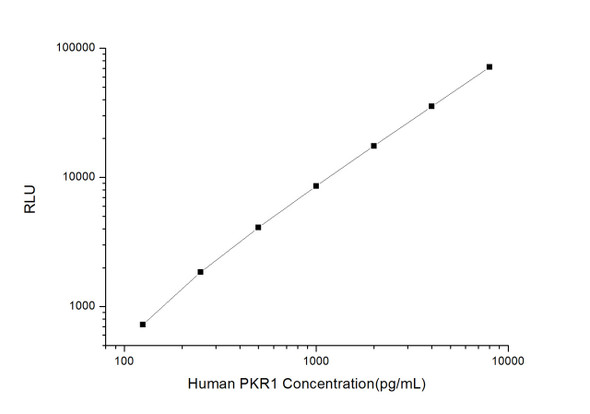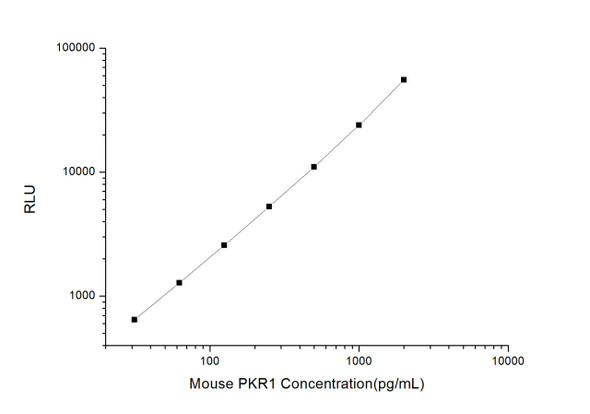Human Cell Biology ELISA Kits 5
Human PKR2 (Prokineticin Receptor 2) CLIA Kit (HUES01015)
- SKU:
- HUES01015
- Product Type:
- ELISA Kit
- ELISA Type:
- CLIA Kit
- Size:
- 96 Assays
- Sensitivity:
- 37.5pg/mL
- Range:
- 62.5-4000pg/mL
- ELISA Type:
- Sandwich
- Reactivity:
- Human
- Sample Type:
- Serum, plasma and other biological fluids
- Research Area:
- Cell Biology
Description
| Assay type: | Sandwich |
| Format: | 96T |
| Assay time: | 4.5h |
| Reactivity: | Human |
| Detection method: | Chemiluminescence |
| Detection range: | 62.50-4000 pg/mL |
| Sensitivity: | 37.50 pg/mL |
| Sample volume: | 100µL |
| Sample type: | Serum, plasma and other biological fluids |
| Repeatability: | CV < 15% |
| Specificity: | This kit recognizes Human PKR2 in samples. No significant cross-reactivity or interference between Human PKR2 and analogues was observed. |
This kit uses Sandwich-CLIA as the method. The micro CLIA plate provided in this kit has been pre-coated with an antibody specific to Human PKR2. Standards or samples are added to the appropriate micro CLIA plate wells and combined with the specific antibody. Then a biotinylated detection antibody specific for Human PKR2 and Avidin-Horseradish Peroxidase (HRP) conjugate are added to each micro plate well successively and incubated. Free components are washed away. The substrate solution is added to each well. Only those wells that contain Human PKR2, biotinylated detection antibody and Avidin-HRP conjugate will appear fluorescence. The Relative light unit (RLU) value is measured spectrophotometrically by the Chemiluminescence immunoassay analyzer. The RLU value is positively associated with the concentration of Human PKR2. The concentration of Human PKR2 in the samples can be calculated by comparing the RLU of the samples to the standard curve.
| UniProt Protein Function: | PROKR2: Receptor for prokineticin 2. Exclusively coupled to the G(q) subclass of heteromeric G proteins. Activation leads to mobilization of calcium, stimulation of phosphoinositide turnover and activation of p44/p42 mitogen-activated protein kinase. Defects in PROKR2 are the cause of Kallmann syndrome type 3 (KAL3); also known as hypogonadotropic hypogonadism and anosmia. Anosmia or hyposmia is related to the absence or hypoplasia of the olfactory bulbs and tracts. Hypogonadism is due to deficiency in gonadotropin-releasing hormone and probably results from a failure of embryonic migration of gonadotropin- releasing hormone-synthesizing neurons. KAL3 patients have variable degrees of olfactory and reproductive dysfunction, but do not show any of the occasional clinical anomalies reported in Kallmann syndrome such as renal agenesis, cleft lip and/or palate, selective tooth agenesis, and bimanual synkinesis. Belongs to the G-protein coupled receptor 1 family. |
| UniProt Protein Details: | Protein type:Membrane protein, multi-pass; Receptor, GPCR; Membrane protein, integral; GPCR, family 1 Chromosomal Location of Human Ortholog: 20p12. 3 Cellular Component: integral to membrane; plasma membrane Molecular Function:neuropeptide Y receptor activity Biological Process: circadian rhythm; neuropeptide signaling pathway Disease: Hypogonadotropic Hypogonadism 3 With Or Without Anosmia |
| NCBI Summary: | Prokineticins are secreted proteins that can promote angiogenesis and induce strong gastrointestinal smooth muscle contraction. The protein encoded by this gene is an integral membrane protein and G protein-coupled receptor for prokineticins. The encoded protein is similar in sequence to GPR73, another G protein-coupled receptor for prokineticins. [provided by RefSeq, Jul 2008] |
| UniProt Code: | Q8NFJ6 |
| NCBI GenInfo Identifier: | 33112425 |
| NCBI Gene ID: | 128674 |
| NCBI Accession: | Q8NFJ6. 1 |
| UniProt Secondary Accession: | Q8NFJ6,Q2M3C0, Q5TDY1, Q9NTT0, A5JUU1, |
| UniProt Related Accession: | Q8NFJ6 |
| Molecular Weight: | 384 |
| NCBI Full Name: | Prokineticin receptor 2 |
| NCBI Synonym Full Names: | prokineticin receptor 2 |
| NCBI Official Symbol: | PROKR2 |
| NCBI Official Synonym Symbols: | HH3; KAL3; PKR2; GPRg2; GPR73b; GPR73L1; dJ680N4. 3 |
| NCBI Protein Information: | prokineticin receptor 2; PK-R2; G protein-coupled receptor 73-like 1 |
| UniProt Protein Name: | Prokineticin receptor 2 |
| UniProt Synonym Protein Names: | G-protein coupled receptor 73-like 1; GPR73b; GPRg2 |
| Protein Family: | Prokineticin receptor |
| UniProt Gene Name: | PROKR2 |
| UniProt Entry Name: | PKR2_HUMAN |
As the RLU values of the standard curve may vary according to the conditions of the actual assay performance (e. g. operator, pipetting technique, washing technique or temperature effects), the operator should establish a standard curve for each test. Typical standard curve and data is provided below for reference only.
| Concentration (pg/mL) | RLU | Average | Corrected |
| 4000 | 53208 64954 | 59081 | 59046 |
| 2000 | 27625 28093 | 27859 | 27824 |
| 1000 | 14211 12757 | 13484 | 13449 |
| 500 | 6325 6885 | 6605 | 6570 |
| 250 | 3378 3108 | 3243 | 3208 |
| 125 | 1628 1534 | 1581 | 1546 |
| 62.50 | 734 776 | 755 | 720 |
| 0 | 34 36 | 35 | -- |
Precision
Intra-assay Precision (Precision within an assay): 3 samples with low, mid range and high level Human PKR2 were tested 20 times on one plate, respectively.
Inter-assay Precision (Precision between assays): 3 samples with low, mid range and high level Human PKR2 were tested on 3 different plates, 20 replicates in each plate.
| Intra-assay Precision | Inter-assay Precision | |||||
| Sample | 1 | 2 | 3 | 1 | 2 | 3 |
| n | 20 | 20 | 20 | 20 | 20 | 20 |
| Mean (pg/mL) | 211.34 | 605.70 | 1956.08 | 197.61 | 600.14 | 1932.79 |
| Standard deviation | 22.00 | 70.56 | 167.05 | 16.42 | 61.09 | 193.67 |
| C V (%) | 10.41 | 11.65 | 8.54 | 8.31 | 10.18 | 10.02 |
Recovery
The recovery of Human PKR2 spiked at three different levels in samples throughout the range of the assay was evaluated in various matrices.
| Sample Type | Range (%) | Average Recovery (%) |
| Serum (n=5) | 84-100 | 91 |
| EDTA plasma (n=5) | 96-110 | 102 |
| Cell culture media (n=5) | 97-112 | 103 |
Linearity
Samples were spiked with high concentrations of Human PKR2 and diluted with Reference Standard & Sample Diluent to produce samples with values within the range of the assay.
| Serum (n=5) | EDTA plasma (n=5) | Cell culture media (n=5) | ||
| 1:2 | Range (%) | 98-112 | 103-117 | 100-115 |
| Average (%) | 104 | 109 | 107 | |
| 1:4 | Range (%) | 94-105 | 89-102 | 85-98 |
| Average (%) | 100 | 95 | 92 | |
| 1:8 | Range (%) | 88-104 | 90-105 | 96-113 |
| Average (%) | 95 | 97 | 104 | |
| 1:16 | Range (%) | 89-101 | 85-99 | 97-112 |
| Average (%) | 94 | 90 | 104 |
An unopened kit can be stored at 4°C for 1 month. If the kit is not used within 1 month, store the items separately according to the following conditions once the kit is received.
| Item | Specifications | Storage |
| Micro CLIA Plate(Dismountable) | 8 wells ×12 strips | -20°C, 6 months |
| Reference Standard | 2 vials | |
| Concentrated Biotinylated Detection Ab (100×) | 1 vial, 120 µL | |
| Concentrated HRP Conjugate (100×) | 1 vial, 120 µL | -20°C(shading light), 6 months |
| Reference Standard & Sample Diluent | 1 vial, 20 mL | 4°C, 6 months |
| Biotinylated Detection Ab Diluent | 1 vial, 14 mL | |
| HRP Conjugate Diluent | 1 vial, 14 mL | |
| Concentrated Wash Buffer (25×) | 1 vial, 30 mL | |
| Substrate Reagent A | 1 vial, 5 mL | 4°C (shading light) |
| Substrate Reagent B | 1 vial, 5 mL | 4°C (shading light) |
| Plate Sealer | 5 pieces | |
| Product Description | 1 copy | |
| Certificate of Analysis | 1 copy |
- Set standard, test sample and control (zero) wells on the pre-coated plate and record theirpositions. It is recommended to measure each standard and sample in duplicate. Note: addall solutions to the bottom of the plate wells while avoiding contact with the well walls. Ensuresolutions do not foam when adding to the wells.
- Aliquot 100 µL of standard solutions into the standard wells.
- Add 100 µL of Sample / Standard dilution buffer into the control (zero) well.
- Add 100 µL of properly diluted sample (serum, plasma, tissue homogenates and otherbiological fluids. ) into test sample wells.
- Cover the plate with the sealer provided in the kit and incubate for 90 min at 37 °C.
- Aspirate the liquid from each well, do not wash. Immediately add 100 µL of BiotinylatedDetection Ab working solution to each well. Cover the plate with a plate seal and gently mix. Incubate for 1 hour at 37 °C.
- Aspirate or decant the solution from the plate and add 350 µL of wash buffer to each welland incubate for 1-2 minutes at room temperature. Aspirate the solution from each well andclap the plate on absorbent filter paper to dry. Repeat this process 3 times. Note: a microplatewasher can be used in this step and other wash steps.
- Add 100 µL of HRP Conjugate working solution to each well. Cover with a plate seal andincubate for 30 min at 37 °C.
- Aspirate or decant the solution from each well. Repeat the wash process for five times asconducted in step 7.
- Add 100 µL of Substrate mixture solution to each well. Cover with a new plate seal andincubate for no more than 5 min at 37 °C. Protect the plate from light.
- Determine the RLU value of each well immediately.






